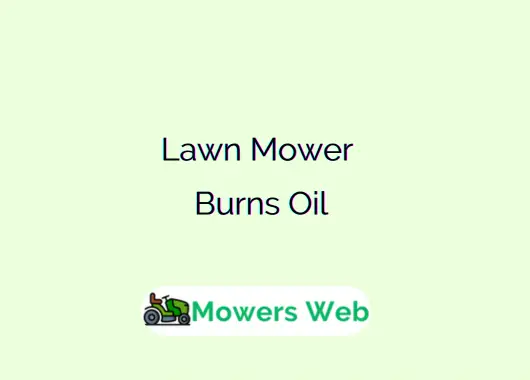If you’ve noticed blue or white smoke billowing from your mower or a constant need to top off the oil, your machine might be burning oil.
In this guide, we’ll explore the reasons behind this issue, its symptoms, and practical steps to diagnose and fix it, ensuring your lawn mower runs smoothly for years to come.
Lawn Mower Burns Oil
1. Worn Piston Rings or Cylinder Walls
Piston rings seal the combustion chamber, preventing oil from leaking into it. Over time, these rings can wear out, especially in older mowers or those with high hours of use. Similarly, the cylinder walls can become scored or worn, allowing oil to seep past the piston and into the combustion chamber. This is one of the most serious causes and often requires significant repair or engine replacement.
2. Damaged or Worn Valve Seals
Valve seals prevent oil from leaking into the combustion chamber through the engine’s valves. If these seals become brittle, cracked, or worn, oil can leak into the chamber, where it’s burned during operation. This issue is common in older engines but is typically less costly to repair than worn piston rings.
3. Overfilled Oil Reservoir
Adding too much oil to the crankcase can cause excess oil to be forced into the combustion chamber. This often happens when owners don’t measure oil properly or misread the dipstick. Overfilling can also lead to increased crankcase pressure, exacerbating oil leaks.
4. Clogged or Faulty PCV System
Many lawn mowers are equipped with a Positive Crankcase Ventilation (PCV) system to manage crankcase pressure. If the PCV valve or breather is clogged or malfunctioning, pressure can build up, pushing oil into the combustion chamber or causing leaks.
5. Improper Mower Operation
Operating a mower at extreme angles, such as on steep slopes, can cause oil to flow into areas it shouldn’t, like the combustion chamber. This is especially common in mowers not designed for hilly terrain.
6. Worn Gaskets or Seals
Crankcase gaskets, head gaskets, or other seals can degrade over time, allowing oil to leak into the combustion chamber or other engine components. These leaks can contribute to oil burning and should be addressed promptly.
Related Why Lawn Mower Backfires(5 Reasons + Solutions)
Fixing a Lawn Mower That Burns Oil
Quick Oil Burning Treatment Products: (Click to Check Prices on Amazon)
> Bar’s Leaks OS-1-4PK Oil Seal Engine Oil Burning
1. Correct Oil Levels
If overfilling is the issue, drain the excess oil and refill to the recommended level using the manufacturer-specified oil type. Always measure oil carefully to avoid recurrence.
2. Replace Valve Seals
Worn valve seals can often be replaced without disassembling the entire engine. Consult your mower’s manual for guidance, and consider professional help if you’re not comfortable with engine repairs.
3. Clean or Replace the PCV System
If the PCV valve or breather is clogged, clean it with carburetor cleaner or replace it if damaged. This is a relatively simple fix that can resolve oil-burning issues caused by crankcase pressure.
4. Replace Gaskets or Seals
Worn gaskets or seals should be replaced. Common areas include the head gasket or crankcase cover. Ensure you use the correct replacement parts for your mower model.
5. Address Worn Piston Rings or Cylinder Walls
If the issue stems from worn piston rings or cylinder walls, repairs can be complex and costly. For older mowers, replacing the engine or the entire mower may be more cost-effective than rebuilding.
6. Adjust Operating Habits
Avoid operating the mower on steep slopes, and follow the manufacturer’s guidelines for proper use. Regular maintenance, such as timely oil changes and air filter cleaning, can prevent oil-burning issues.
Related Low Oil Symptoms in Lawn Mowers (Don’t Ignore These Signs)
Symptoms of a Lawn Mower Burning Oil
Identifying the problem early can save you from costly repairs. Look out for these signs:
- Blue or White Smoke: Excessive smoke from the exhaust, especially during startup or operation, is a primary indicator.
- Frequent Oil Top-Offs: If you’re constantly adding oil, it’s likely being burned or leaking.
- Fouled Spark Plugs: Oil in the combustion chamber can coat spark plugs, causing misfires or rough operation.
- Reduced Engine Performance: Burning oil can lead to carbon buildup, reducing power and efficiency.
- Oil Smell: A burnt oil odor during operation is another red flag.
Related Best Oil for a Lawn Mower(Top 5 PICKS 2025)
How to Diagnose the Problem
Before diving into repairs, diagnose the issue to pinpoint the cause:
- Check Oil Levels: Use the dipstick to ensure the oil level is within the recommended range. Drain excess oil if overfilled.
- Inspect for Leaks: Look for oil around gaskets, seals, or the air filter housing.
- Examine Spark Plugs: Remove and inspect the spark plug for oil residue or carbon buildup.
- Test Compression: A compression test can reveal worn piston rings or cylinder walls. Low compression indicates internal engine wear.
- Check the PCV System: Inspect the breather or PCV valve for clogs or damage.
- Review Operation Habits: Consider whether you’ve been using the mower on steep slopes or neglecting maintenance.
Related Riding Mower Making Noise When Blades Are Engaged(Fixed)
Preventing Oil Burning in the Future
Prevention is always better than repair. Follow these tips to keep your lawn mower in top shape:
- Regular Maintenance: Change the oil and air filter as recommended by the manufacturer.
- Use the Right Oil: Always use the oil type and viscosity specified in the owner’s manual.
- Store Properly: Store the mower on a level surface to prevent oil from pooling in the wrong areas.
- Monitor Usage: Avoid overloading the mower or using it in conditions it’s not designed for.
Related Lawn Mower Makes Grinding Noise When Trying to Start(Solved)
FAQs
Why does my lawn mower burn oil?
Oil burns when it enters the combustion chamber due to worn piston rings, valve seals, overfilled oil, or a faulty PCV system.
How do you fix an engine that burns oil?
Drain excess oil, replace worn valve seals or gaskets, clean the PCV system, or repair/replace the engine if piston rings or cylinder walls are worn.
What is the most common cause of burning oil?
Worn piston rings or valve seals are the most common causes, allowing oil to leak into the combustion chamber.
Why blowing oil from the exhaust?
Oil in the exhaust usually results from overfilled oil, worn piston rings, or damaged valve seals letting oil into the combustion chamber.
How to tell if lawn mower piston rings are bad?
Low compression, excessive blue smoke, and oil consumption indicate bad piston rings; a compression test confirms the issue.
How to tell if a mower engine is damaged from no oil?
Look for a seized engine, loud knocking, overheating, or metal shavings in the oil, indicating severe internal damage.
Final words
A lawn mower burning oil is a problem that shouldn’t be ignored, as it can lead to further engine damage and costly repairs. By understanding the causes, such as worn piston rings, faulty seals, or improper operation, you can take targeted steps to fix the issue.
Regular maintenance and proper usage are key to preventing oil burning and extending the life of your mower. If you’re dealing with persistent smoke or oil loss, start with a thorough diagnosis and address the root cause promptly. With the right care, your lawn mower will keep your yard looking sharp without burning through oil.




